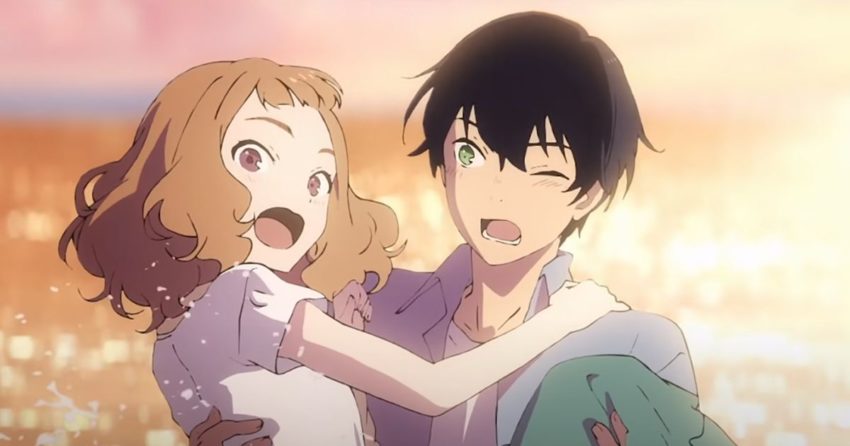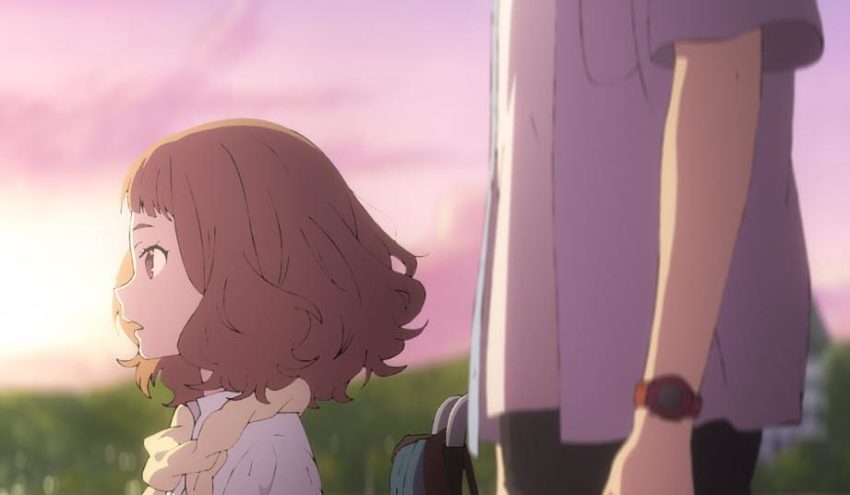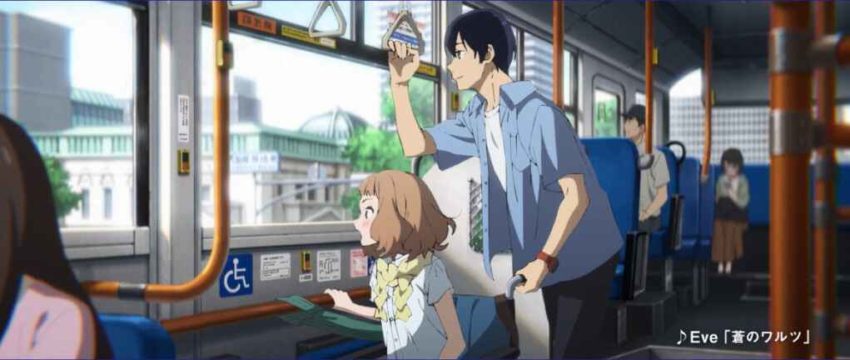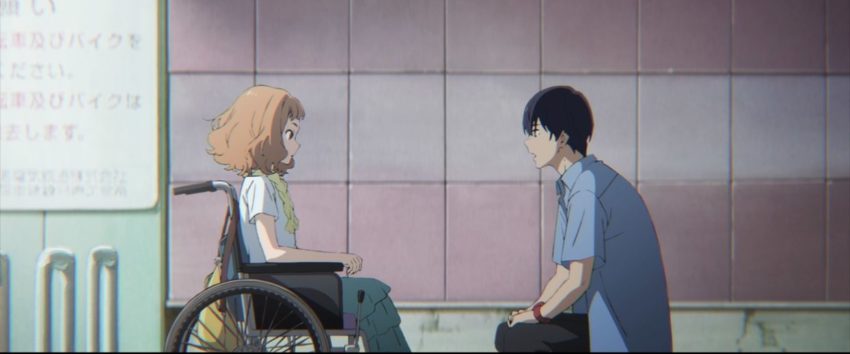Josee, the Tiger and the Fish
July 12, 2021 · 2 comments
By Jonathan Clements.

Struggling to make ends meet, Tsuneo is scrimping together all his spare cash to fund the trip of a lifetime – a graduate posting in Mexico where he can indulge his love of diving. He is so set on this aim that he doesn’t realise that his co-worker Mai is carrying a torch for him, even though his best friend Hayato repeatedly tries to point this out. But Tsuneo’s life changes after an evening encounter with Kumiko, a girl in a runaway wheelchair.
“They come from different backgrounds, they think differently and they would never usually meet,” says producer Masahiko Minami. “But this film starts with them meeting, and when I read the script I thought this was a really sweet, really endearing, realistic but also fantastic story.”
Kumiko’s frail grandmother makes Tsuneo an offer he can’t refuse, cash money for the deceptively simple job of being Kumiko’s daytime carer and minder. Kumiko, however, is not the easiest of clients, but an embittered, angry young woman who despises Tsuneo from the moment they first meet.

“In most anime love stories,” says director Kotaro Tamura, “the leads are teenagers, but here they’re both in their twenties, which I think makes it quite unusual in Japanese animation.” It is also, however, unusual for Bones, the studio that made it.
“Over the last 22 years,” notes Minami, “Bones has usually produced anime full of action, robots, and missiles. But now, for the first time, we have tackled a piece of pure literature. Probably the first of our releases that doesn’t have any explosions in it.”
Much as The Deer King’s pandemic plot seems to have achieved new and unexpected resonance on its release in 2021, Josee and the Tiger and the Fish’s tale of a woman trapped in an unending lockdown is sure to seem a little too close for comfort for some contemporary viewers. The script even hangs a lantern on the discombobulation today’s audiences might feel about a depiction of “normal” life – People in bars! People in restaurants! – by setting itself next year. As Hayato observes in one early scene, it’s set in the “summer of 2022”, a near-future dreamtime for which everybody, animators and audience alike, can imagine the pre-COVID world restored once more. One wonders if this, too, was not some attempt at hedging their bets, in order to avoid setting a contemporary film in the summer of 2021 just in case all the cinemas were shut down again.
“The release was originally planned for the end of August 2020,” says Minami.” “Tsuneo loves diving, and there’s a lot of beach scenes, which is why we originally wanted to release it in the summer. But because of the production delays, and also because of the closed cinemas, that was put back. But the film does go through all four seasons, so a Christmas release was also meaningful in terms of the content of the story.” Eventually, the film made it to Japanese cinemas on Christmas Day 2020. “We’re all back in the studio now, but I think [the pandemic] really accelerated our adoption of digital animation,” he adds. “However, the people who are responsible for the different stages of the production process all need to talk to each other, and in that sense, we are analogue creatures and it is better for us to be together.”
It wasn’t originally a 21st-century tale. Seiko Tanabe’s short story of the same name was published in 1984, two years before the release of Children of a Lesser God, and a decade before the J-dorama Pure ushered in a decade of disability stories on Japanese television. In other words, Tanabe’s original hails from a whole generation before the likes of A Silent Voice and I Want to Eat Your Pancreas seemed to create the sub-genre all over again, as a series of entitled young men were forced to check their various privileges after an encounter with a girl who was deaf, or dying of something, or only had one leg, or… Apologists for this sort of story see in them a form of empowerment and empathy – a cynic might see a procession of wounded birds and fallen angels, pixie-dreamgirls dropping into a guy’s life before (it often seems) handily dying before they get in the way too long. Tanabe’s story, however, has become a classic of the form, already adapted as a 2003 Japanese live-action movie, which was itself remade in South Korea in 2020 with the title Josée (pictured).

It’s hence rather refreshing to get back to Tanabe’s original here, which truly does empower and empathise with its female lead, for starters by making her such a colossal cow. Kumiko is no happy-go-lucky ray of sunshine or over-achieving “super-crip” – she has been browbeaten and downtrodden by the never-ending trauma of her condition. Even at her first appearance, there is the suggestion that somewhere off-screen someone has literally just tried to murder her. And if being constantly belittled and patronised has got to her after a while, then it’s hardly any surprise that she should bite Tsuneo’s hand and call him a pervert, even after he has saved her life by becoming a human crash-mat.
In fact, the film’s opening act does such a good job of capturing Kumiko’s acid tongue, negative attitude and rage against the world, that it creates a serious obstacle for the creative staff to rein her back in and make her remotely likeable. Even her nickname “Josee” has been chosen for its evocation of unpleasantness – her namesake comes from the Francoise Sagan novel, Merveilleux Nuages, a character who is similarly hard work… no wonder Tsuneo has to be literally paid to keep her company. And for those who collect the myriad Japanese words for “I”, she uses neither the girlish “atashi” or the blokey “boku”, but instead refers to herself as “attai”, which as my Japanese teacher once blushingly explained many years ago: “…is only used by bad girl, and girl that carry knife.”
It’s Grandma one feels most sorry for, the old lady who has spent years caring for her orphaned grand-daughter, but now faces the prospect that she will not be able to do so for much longer. Kumiko thinks that Grandma’s refusal to go on their night walks are a punishment, but for Grandma it is a recognition that she can’t cope any more. It’s not until Tsuneo reluctantly agrees to take Kumiko to the seaside that he discovers how marginalised she is in a world of train-station staircases and high-stepped kerbs. And that’s before we get to the Tigers – the snarling people of the city, who refuse to cut any slack to the girl in a wheelchair. In a challenge to Japanese norms, the film presents anger, disruption and rocking the boat as the only ways to break through a society that deals with problems by pretending they are not there.

“I did go out and about in a wheelchair,” says Tamura, “to try to experience the viewpoint of someone who uses one and the struggles that they face. I’d heard a lot about how things were supposed to be ‘barrier-free’ and ‘accessible’, but when you’re in the chair, there are so many new obstacles. Even a small step would make a huge difference, and I’d have to take a long way around to avoid it.”
In an era when every single anime out of Japan seems to come attached to some sort of tourist initiative, it’s also lovely to see Osaka finally get its moment in the sun, with loving backgrounds that take the viewer through a year of four distinct seasons. Japan’s “second city”, its Glasgow or Birmingham if you will, Osaka itself has something of a chip on its shoulder, not as big as the bustling Tokyo, not as classy as the old-time capital Kyoto, which is so close to it that the two cities share a metro system. When Hayato off-handedly thanks Tsuneo with “O-kini” instead of “Arigato,” it’s a tiny fist-bump for a dialect and an attitude that is so often sidelined in anime settings that are either all-Tokyo, all-the-time, or some obscure dormitory suburb that’s fronted enough cash to become the next “holy land” for otaku visitors.
The film even works in a quick glimpse of the Glico billboard, an unassuming 1930s advertising hoarding in Dotonbori, suggested by local wags as the closest thing that Osaka has ever had to a “landmark.” When Shonen Knife sang of “My Favourite Town Osaka”, the punk element of their love-song to their home was that only deliberately contrary musicians would dare suggest it could be anyone’s favourite anything.

Josee spends its first fifteen minutes relentlessly establishing its realist credentials, focussing on the kipple and clutter of Grandma’s house, and the boisterous clatter of Osaka night-life. Then, in an about-face, it dives into the characters’ dreamworlds – an underwater mermaid fantasy in which Kumiko’s legs are no longer a handicap, and Tsuneo gets to wander in the natural habitat of his beloved fishes. Creating such dreamscapes required the animators to drown the city, which in turn creates unexpected resonances with Makoto Shinkai’s recent Weathering with You. But it’s The Little Mermaid that Josee most seems to echo, not the merry Disney musical, but the howl at the world of the Hans Christian Andersen original, a girl for whom walking feels like stepping on knives, dragging herself with agonising slowness across the long, long beach towards the sea.
The script is by Sayaka Kuwamura, an experienced writer in film and TV drama who has never worked in anime before. “We deliberately chose her,” says Tamura, “because we thought that a live-action way of thinking would suit this film better. I’d never seen the 2003 film, but when we were talking about the script, Kuwamura-san said that she really liked it. So, she was probably more influenced by the live-action film, whereas I was basing my ideas on the prose story.”
Kuwamura’s script deftly hurls in some wonderful surprises, finding moments of humour even in supposedly sad scenes, but also repeatedly “forgetting” subtexts, only to smuggle them back in somewhere in the dialogue. After their first journey, a dash to the seaside against Grandma’s wishes, Tsuneo and Kumiko chat about their shared love of the ocean – his practical, hers entirely theoretical. But it’s only then that she finds out that he works in a diving shop, although the two have already spent literally weeks in each other’s company. This only reinforces the power of the previous scene, revealing that they really have remained impersonal strangers to each other until that moment. The story also returns periodically to consideration of the life of a shut-in – Kumiko might have a rich life of the mind, imagining far-fetched and impressionistic artworks of faraway places, but she is deprived, as so many of the rest of us have been for months on end, of simple pleasures like going to a café or buying a crepe, or visiting a craft shop. Oh, and libraries. Remember libraries?

The story also returns to dreams, as reveries to shoo away a savage world, or as plans to cherish for the future. Tsuneo’s dream, of moving to Mexico for post-graduate study, is tantalisingly close. Kumiko’s dream, of supporting herself by becoming an artist, seems achingly beyond the realms of possibility, as is made clear to her by the brusque, dismissive tone of the social worker who scoffs at her ambitions.
Josee presents a textbook case of what Russell T. Davies has called the “heterosexuality” of drama – that if we see two people of the opposite sex together onscreen, we will immediately assume that something is going to happen. Much of that tension in Josee remains tantalisingly below the surface, as Tsuneo’s co-worker Mai repeatedly tries in vain to get his attention. We get to seethe with Kumiko at how easy Mai really has it. And we get to fret with Kumiko at the elephant that looms constantly in the room as the film passes its mid-point – the fact that Tsuneo has been her paid companion all along, and that there is no guarantee at all that he will stick around the moment the money dries up. He has, in fact, been so open about the financial incentive that he has even named the household’s adopted cat Yukichi, after Yukichi Fukuzawa, the man whose portrait appears on the 10,000-yen note – Japan’s equivalent of being “all about the Benjamins.”
It’s Mai who appoints herself the bearer of bad tidings, bowing to Kumiko at a super-supplicant 90-degrees, and begging her to “free” Tsuneo from the obligation into which the couple have inadvertently settled.

It’s the hope that kills you. Kumiko’s attitude early in the film is revealed as a shield to lower both her own expectations and those that others might have of her. There is, she claims to Tsuneo, no point in reaching for anything. What’s the point in having dreams? “The healthy wouldn’t understand,” she says to Tsuneo, suggesting that they really do live in different worlds – his, an ableist paradise of possibilities, and hers, a disabled dystopia of disappointments. Ableism, in fact, is an understandably recurring theme in the story, not only of the assumptions in architecture and society that do not consider the needs of the disabled, but in the assumption that disability itself is a “disabling” condition. Tsuneo is confronted with the manner in which hopes, dreams and aspirations can be wiped out in a single moment of bad luck, and given some glimpse of how Kumiko’s life has looked all along. Much like the protagonists of the thematically similar A Silent Voice, a pair of characters respectively deal with the literal or figurative nature of a particular problem, each coming to understand a little of how the other must feel.
But Kuwamura’s script is soon back again with her subtle digs. Because when Mai finally does get around to proclaiming her love for Tsuneo, we get to see it through Kumiko’s eyes, not as a turning point in a romantic drama, but as a dreadful proposition – a woman using the phrasing of romance to conceal an attempt to get him to give up on his dreams. Mai has been set up all along as a traditional romantic interest, but Kuwamura’s script gets its hands gleefully dirty asking what that actually means. In a tense confrontation with Kumiko, the two women score points off each other about who knows him best. It soon becomes apparent that while Mai knows a broad selection of Tsuneo trivia, it’s Kumiko who really gets him.
Or does she? Twists and turns late in the day keep the audience guessing right up until the end and, indeed, through the credits. A coda finally wraps everything up, along with a knowing gag at the expense of Ride Your Wave, an anime feature that started out very similar to Josee, but turned out very differently by its end.
“I describe it as a young love story,” says director Tamura. “But it’s not just about love, it uses a love story to talk about other things. If you’ve seen the posters, your eyes might have been drawn to ‘Josee’s’ wheelchair. But this isn’t really about the wheelchair. It’s not about being disabled. Yes, her legs don’t work, but what really doesn’t work is her heart, and there’s something similar about Tsuneo, too, there is plenty to empathise with in both characters. And so, I hope people can cast off any preconceptions and just come along and watch the film.”
Jonathan Clements is the author of Anime: A History. Josee the Tiger and the Fish will be released in UK cinemas on 11th August.
anime, Bones, cinema, Jonathan Clements, Josee the Tiger and the Fish, Kotaro Tamura, Masahiko Minami
Ian
March 23, 2022 8:44 pm
I have only just now seen this film (Covid meaning unfortunately I wasn't able to see it in the cinema) and it is an absolutely lovely film. I have to say, having gone to a school for disabled children, and then later worked as a support worker for disabled uni students, there is a *lot* that this film gets spot on that many others don't. Sure there's a few things that feel a bit contrived - attempts to create a 'love triangle' arc, for example... But overall it's a beautifully told story, and there's some scenes where the animation is so well done it stays long in your memory. So, thank you to the All The Anime blog for putting this film up on my radar!
moniji
July 21, 2022 4:01 pm
I'm in a wheelchair myself, that made me even more curious about this movie. I loved this movie very much. Love the score too Great to have a heroine in a wheelchair. I’ve been to Osaka. Having the city as a backdrop for the film was great. I regonized some spots. I cried at the ending.